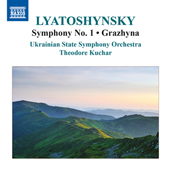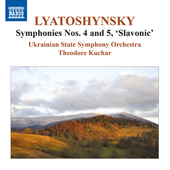
ESSENTIAL RECORDINGS



Holy *$#! - There are long passages in all five of these symphonies that will quite simply take your breath away and pin you to your seat. I can't believe that I
have never heard one note of the music of Ukrainian composer Boris Lyatoshynsky (1895-1968) until now. These are not new recordings. They
were in fact previously released (right under my nose) on the Marco Polo label back in 1994, and re-issued this month on the Naxos label. He's considered the father
of contemporary Ukrainian music. In general, his style of writing and orchestration could be perceived as an amalgamation of Rimsky-Korsakov, Tchaikovsky,
Scriabin, Granville Bantock and Reinhold Glière. Not surprisingly, since he studied composition under Glière at the Kiev Conservatory, but you can definitely feel his own
mature style evolve as you move up the numbers, and break out completely by the time he's reached the Fourth Symphony in 1963.
Barely 45 seconds into the Symphony No. 1 in A major, Op. 2 and you're already deep into Scriabin territory, with its constant ebb
and flow of energy, and surges of passion. Its première in 1919 was conducted by Reinhold Glière himself. Not bad for a graduation piece. It's believed to be the
first symphony written in the Ukraine. You can notice right away that Lyatoshynsky was very good at developing ideas, creating conflict, and building tension with the use of multi-layered
counterpoint and lush orchestration and, unlike Glière, was even better at releasing tension and resolving harmonic and thematic imbroglios. The portentous
conclusion of this symphony is a great example of just that.
The Symphony No. 2 in B flat, Op. 26 was composed in 1935-36, around the same time as the No. 4 by Shostakovich, and along
with it, was singled out by the authorities as being overly complex and negative. So along with Shostakovich and Prokofiev, his music was banned from the concert
halls. Its first performance was delayed until 1941. Personally I don't see the connection. This music sounds nothing like Shostakovich. It's missing the "soviet"
element so prevalent in Prokofiev, Shostakovich and others from that generation. Despite all that it's turning out to be one of my favorites of all his symphonies.
What with its dark and stormy first movement, beautifully lyrical slow movement, and boisterous and thrilling final movement in which an extended heavy percussion
segment "hints" at Shostakovich.
Even after being labelled a "formalist", reprimanded for not writing music for the people and constantly receiving severe criticism based on his Second Symphony,
Lyatoshynsky went on to write (15 years later) the powerful Symphony No. 3 in B minor, Op. 50, which eventually grew to become
his most performed and highly esteemed of all. Not surprising once you've heard the fiercely intense and masterfully scored opening movement, the brilliantly orchestrated and oddly cinematic
feel of the slow movement, and the brassy heroic optimism clashing with the deeply melancholic strings in the fourth movement, coming together in the end to
cap the whole symphony with powerful energy. All the earmarks of a crowd pleaser.
By 1963, ten years after the death of Joseph Stalin, the composer felt it was time to come out from the closet of suppression and fully express himself. And
the first few bars of his Symphony No. 4 in B flat minor, Op. 63 certainly break the door down without hesitation and with tremendous force.
And like most composers from his generation, you can tell that a dark malaise and disquiet has crept in behind every note. The Lento tenebroso ends
with feelings of regret, sorrow, anger and resignation, only to be shattered by the salvo of violent declamations that open the final movement. A movement of
tremendous struggles and conflicts, expertly balanced by the composer, which surprisingly ends in quiet peace. On the other hand, his Symphony
No. 5 in C major, Op. 67, 'Slavonic' gazes backward through ancient Slavic history by its use of folk tunes from Russia, Bulgaria and Yugoslavia.
Its slow middle movement is particularly haunting, and the final four minutes, with bold orchestration including bells clanging their own song, ends the symphony
on a high note.
American conductor Theodore Kuchar has released many fine recordings over the years on various labels, and seems to have championed
Russian composers in particular including Kalinnikov, Khachaturian, Tchaikovsky, Prokofiev, Shchedrin, Rimsky-Korsakov and Shostakovich, therefore this cycle
of all the Symphonies of Boris Lyatoshynsky is no exception. He reads the composer's mind by providing forceful accounts of the heavier
aspects of these works and highlighting their wide orchestral colors, while maintaining a clear and constant eye on the symphonic thread that runs through them.
If you passed on these when they first came out on Marco Polo at full price, don't miss out on them now, re-issued on Naxos at budget price.
Like me, you may wonder how you could have possibly missed music this good.
Jean-Yves Duperron - November 2014